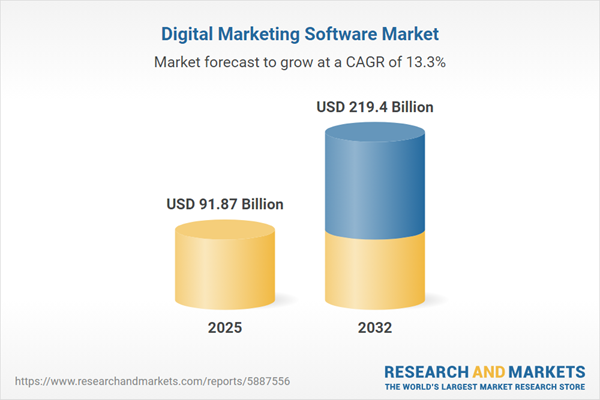Speak directly to the analyst to clarify any post sales queries you may have.
Digital marketing software is redefining how businesses engage their audiences, respond to shifting expectations, and harness analytics for customer experience management. Senior decision-makers are increasingly prioritizing solutions that enable omnichannel strategies, advanced personalization, and operational efficiency in a rapidly evolving landscape.
Market Snapshot: Digital Marketing Software Market Size and Growth
The digital marketing software market demonstrated robust growth, advancing from USD 80.89 billion in 2024 to USD 91.87 billion in 2025. Propelled by ongoing innovation and an anticipated compound annual growth rate (CAGR) of 13.28%, the market is forecasted to reach USD 219.40 billion by 2032. This trajectory reflects increasing investments in automation, analytics, and omnichannel capabilities as organizations strive for greater differentiation and customer loyalty.
Scope & Segmentation
- Device Types: Android, iOS, and web platforms empower both mobile-first and in-depth campaign management approaches.
- Deployment Modes: Cloud and on-premise options cater to organizations' needs for scalability or heightened data governance.
- End-User Industries: Banking, financial services, insurance, healthcare (including hospitals and pharmaceuticals), manufacturing (automotive, consumer products), retail, and e-commerce leverage digital marketing solutions for compliance, scale, and engagement.
- Organization Sizes: Large enterprises, medium, micro, and small businesses all require tailored feature sets and deployment models.
- Billing Types: One-time licenses and flexible subscription models—both annual and monthly—enable organizations to match expenditures with campaign rhythms and strategic needs.
- Regional Coverage: Comprehensive insights for North America (United States, Canada, Mexico), Latin America (Brazil, Argentina, Chile, Colombia, Peru), Europe (United Kingdom, Germany, France, Russia, Italy, Spain, Netherlands, Sweden, Poland, Switzerland), Middle East (United Arab Emirates, Saudi Arabia, Qatar, Turkey, Israel), Africa (South Africa, Nigeria, Egypt, Kenya), and Asia-Pacific (China, India, Japan, Australia, South Korea, Indonesia, Thailand, Malaysia, Singapore, Taiwan).
- Key Companies: Profiles include Adobe Inc., Salesforce, Oracle, SAP SE, HubSpot, IBM, Microsoft, The Rocket Science Group, ActiveCampaign, and Constant Contact.
Key Takeaways for Senior Decision-Makers
- API-driven architectures and low-code tools are enabling broader access to marketing automation, reducing IT dependency across organizations and supporting agile campaign management.
- Heightened consumer demand for privacy is steering organizations to adopt platforms with advanced consent management and transparent data practices.
- Artificial intelligence and machine learning continue to unlock hyper-personalized content delivery and precise campaign targeting, giving marketers deeper insight into customer journeys.
- The transition toward unified analytics, real-time dashboards, and integrated performance tracking is improving attribution and enabling rapid response to campaign performance trends.
- Strategic alliances and acquisitions are fueling ecosystem expansion, ensuring competitive differentiation and strengthening vendor capabilities in data orchestration and generative AI.
- Omnichannel orchestration—combining channels like email, social, and programmatic advertising—is becoming essential for meeting customers where they are and maximizing engagement opportunities.
Impact of 2025 Tariffs on Global Supply Chains and Vendor Strategies
United States tariffs introduced in 2025 have added complexity to global supply chains for digital marketing software, affecting hardware sourcing and infrastructure costs. This prompted technology providers to localize data centers, adapt licensing, and stabilize delivery through strategic partnerships and acquisitions. Organizations are increasingly evaluating deployment choices and diversifying service providers to maintain continuous operations and cost efficiency.
Research Methodology & Data Sources
This analysis draws on a blend of primary and secondary research, including industry reports, in-depth interviews with executive stakeholders, and structured surveys across organizational sizes and industries. Findings were rigorously validated through data triangulation and expert review, ensuring comprehensive and reliable insights for strategic planning.
Why This Report Matters
- Enables executive teams to align technology investments with evolving customer expectations, regulatory requirements, and market dynamics in digital marketing software.
- Provides detailed segmentation and competitive insights that inform vendor shortlisting, investment decisions, and future-ready marketing strategy development.
- Delivers actionable recommendations for building agile, resilient digital marketing infrastructures, optimizing ROI, and sustaining a data-driven competitive edge.
Conclusion
The digital marketing software market landscape remains fluid, influenced by consumer behavior changes, regulatory shifts, and technology innovations. Leaders who adapt strategically and leverage actionable insights are best positioned to realize sustained growth and scalable customer engagement in the years ahead.
Additional Product Information:
- Purchase of this report includes 1 year online access with quarterly updates.
- This report can be updated on request. Please contact our Customer Experience team using the Ask a Question widget on our website.
Table of Contents
3. Executive Summary
4. Market Overview
7. Cumulative Impact of Artificial Intelligence 2025
Companies Mentioned
The companies profiled in this Digital Marketing Software market report include:- Adobe Inc.
- Salesforce, Inc.
- Oracle Corporation
- SAP SE
- HubSpot, Inc.
- International Business Machines Corporation
- Microsoft Corporation
- The Rocket Science Group LLC
- ActiveCampaign, LLC
- Constant Contact, Inc.
Table Information
| Report Attribute | Details |
|---|---|
| No. of Pages | 185 |
| Published | November 2025 |
| Forecast Period | 2025 - 2032 |
| Estimated Market Value ( USD | $ 91.87 Billion |
| Forecasted Market Value ( USD | $ 219.4 Billion |
| Compound Annual Growth Rate | 13.2% |
| Regions Covered | Global |
| No. of Companies Mentioned | 11 |









